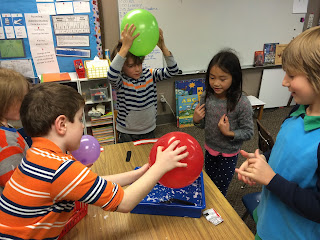We also read a GREAT book this week called Mesmerized - How Ben Franklin Solved A Mystery That Baffled All of France, by Maria Rockliff. In it, Franklin uses the scientific method to test Dr. Mesmer's astounding, and seemingly magic, healing powers. In the process, he essentially invents the "blind" study and discovers the idea of the placebo effect. The ensuing discussion led to some interesting observations about science vs. pseudoscience.
We followed up the reading by playing a game called "Black Magic," with one student exhibiting apparently amazing feats of mental acuity by guessing an object chosen by the rest of the class in their absence. The student playing Dr. Mesmer would leave the room, the rest of the class would pick an object, and then "Dr. Mesmer" would return. I would point at different things around the room asking "Is this the object?" until the student identified the correct one. Each time, no matter who played Dr. Mesmer's role, the student was able to identify the object after only a few guesses. It was amazing! We had not realized we had a class full of mind readers! I was accused of cheating, of somehow communication to Dr. Mesmer the object chosen. "But," I pointed out, "Dr. Mesmer left the room each time BEFORE we chose the object. There was no way I could have given away the answer -- even I did not know it yet!" After several rounds, the students had not yet noticed the pattern that each time, right before the student guessed the correct object, I touched something black. We would have gone on all day if I hadn't gotten carried away and made a mistake. Ah ha! Would Ben Franklin have noticed the pattern? I think perhaps he would have.
We then put our own skills at observation to the test. First, we did some static electricity experiments with the Navigators, combing our hair and rubbing balloons against ourselves and then picking up bits of tissue paper. We recorded our results using the I observe ..., I think..., I wonder... method.
The next morning, we observed another interesting electrical phenomenon -- a plasma ball.
Here's what we observed:
Here's what we thought:
Here's what we wondered:
We are really learning to observe and question. Next week -- we move on to how to turn our questions into hypotheses and begin the scientific process. Oh, and we'll be stopping in to visit this cool website somewhere along the way: http://wonderopolis.org/wonder/how-does-a-plasma-ball-work
Thanks, Ben! And Shock on!
























































